1. 何良年等,绿色化学基本原理. 科学出版社,北京.(ISBN:978-7-03-057791-7,2018年6月第一次印刷.)
2. Mei-Yan Wang, Ning Wang, Xiao-Fang Liu, Chang Qiao and Liang-Nian He*, Efficient Tungstate catalysis: pressure-switched 2- and 6- electron reductive functionalization of CO2 with amines and phenylsilane, Green Chem., 2018, 20, 1564-1570. [link]

Abstract: An efficient and environmentally benign tungstate catalysis for reductive functionalization of CO2 with amines and phenylsilane was developed. By simply varying the pressure, 2-electron or 6-electron reduction of CO2 successfully approached with simultaneous C-N bond formation, thus leading to the formation of formamides and methylamines, respectively. That is, secondary and primary amines furnished the corresponding methylamines or dimethylamines in excellent yields under atmospheric pressure of CO2, while various formamides were formed in yields ranging from 52% to 98% when increasing the CO2 pressure to 2 MPa. 1H NMR studies and control experiments demonstrate that the N-formylation undergoes the formation of silyl formate while the N-methylation proceeds through an aminal intermediate generated by 4-electron reduction of CO2.
3. Xian-Dong Lang, Liang-Nian He,* Integration of CO2 Reduction with Subsequent Carbonylation: Towards Extending Chemical Utilization of CO2, ChemSusChem, 2018, 11, 2062-2067. [link]

Abstract: Currently, it still remains a challenge to amplify the spectrum of chemical fixation of CO2, although enormous progress has been achieved in this field. In view of the widespread applications of CO in a myriad of industrial carbonylation processes, an alternative strategy is proposed in which CO2 reduction to CO is combined with carbonylation with CO generated ex situ, which affords efficiently pharmaceutically and agrochemically attractive molecules. As such, CO2 in this study was efficiently reduced by triphenysilane using CsF to CO in a sealed two‐chamber reactor. Subsequently, palladium‐catalyzed aminocarbonylation, carbonylative Sonogashira coupling of aryl iodides, and rhodium(I)‐mediated Pauson–Khand‐type reaction proceeded smoothly to yield amides, alkynones, and bicyclic cyclopentenones, respectively. Furthermore, the formed alkynones can further be successfully converted to a series of heterocycles, for example, pyrazoles, 3a‐hydroxyisoxazolo[3,2‐a]isoindol‐8‐(3aH)‐one derivatives and pyrimidines in moderate yields. The striking features of this protocol include operational simplicity, high efficiency, and relatively broad application scope, which represents an alternative avenue for CO2 transformation.
4. Xiao-Ya Li, Su-Su Zheng, Xiao-Fang Liu, Zhi-Wen Yang, Tian-You Tan, Ao Yu*, Liang-Nian He*, Waste Recycling: Ionic Liquid-Catalyzed 4-Electron Reduction of CO2 with Amines and Polymethylhydrosiloxane Combining Experimental and Theoretical Study, ACS Sustain. Chem. Eng., 2018, 6, 8130-8135. [link]
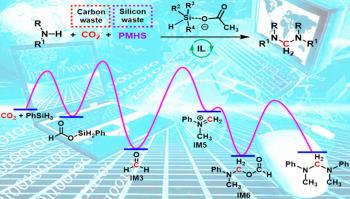
Abstract: The acetate-based ionic liquids (ILs), e.g., [nBu4N]OAc, have been developed for challenging 4-electron reduction of CO2 with amines and hydrosilane to afford aminals. Notably, polymethylhydrosiloxane, a cheap byproduct of the silicone industry, also works well as a reductant. Furthermore, an alternative pathway is rationally proposed via thorough density functional theory (DFT) study. In addition, the ILs play a surprisingly significant role through decreasing activation free energy. More importantly, the essence of being kinetically favorable with 4-electron reduction and thermodynamically favorable with 6-electron reduction is unveiled by DFT study, which guides us to successfully get 6-electron reductive products of CO2, i.e., methylamine. This work represents upgrading usage of both carbon and silicon wastes to valuable chemicals via IL catalysis.

5. Xiao-Fang Liu, Xiao-Ya, Li, Chang Qiao, Liang-Nian He,* Transition-Metal-Free Catalysis for Reductive Functionalization of CO2 with Amines, Synlett 2018, 29, 548-555. [link]
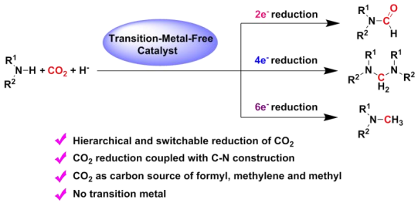
Abstract: Reductive functionalization of CO2 with amines and a reductant, which combines both reduction of CO2 and C-N bond formation in one-pot to produce versatile chemicals and energy-storage materials i.e. formamides, aminals and methylamines that are usually from petroleum feedstock would be appealing and promising. Herein, we give a brief review on recent development in the titled CO2 chemistry by employing transition-metal-free catalysis, which can be catalogued as below according to the diversified energy content of products, i.e. formamides, aminals and methylamines being consistent with 2-, 4- and 6-electron reduction of CO2, respectively. Notably, hierarchical reduction of CO2 with amines to afford at least two products e.g. formamides and methylamines could be realized with the same catalyst through tuning the hydrosilane type, reaction temperature or CO2 pressure. Finally, the opportunities and challenges on the reductive functionalization of CO2 with amines are also highlighted.
6. Xiao-Fang Liu, Chang Qiao, Xiao-Ya, Li, Liang-Nian He,* DMF-promoted reductive functionalization of CO2 with secondary amines and phenylsilane to methylamines, Pure Appl. Chem. 2018, 90(7): 1099-1107. [link]
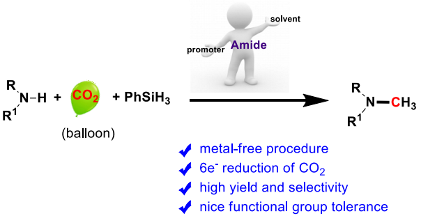
Abstract: An amide-promoted protocol was developed for the reductive functionalization of CO2 with amines/imine and phenylsilane to produce methylamine. Various amines including aromatic and aliphatic, primary and secondary ones as well as imine were methylated successfully to methylamines with up to 98% yield under atmospheric pressure of CO2 and 80 oC. Furthermore, a tentative mechanism involving that amide-promoted CO2 reduction to the silyl acetal species was proposed. Striking features of this metal-free protocol are selective six-electron reduction of CO2 with hydrosilane as a reductant in the presence of amine.
7. Qing-Wen Song, Ping Liu, Li-Hua Han, Kan Zhang*, Liang-Nian He*, Upgrading CO2 by incorporation into urethanes through silver-catalyzed one-pot stepwise amidation reaction Chin. J. Chem., 2018, 36, 147-152. [link]
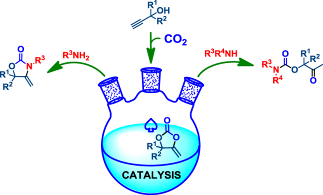
Abstract: One-pot two-step stepwise reaction of terminal propargylic alcohols, carbon dioxide, and primary/secondary amines for the effective synthesis of various urethanes through robust silver-catalysed C-O/C-N bond formation is reported. Catalytic activities were investigated by controlling catalyst loading, reaction pressure and time, and very high turnover number (turnover frequency) was obtained: 3350 (35 h−1) with 0.01 mol% silver catalyst under 0.1 MPa, and up to 13360 (139 h−1) with 0.005 mol% silver catalyst under 2.0 MPa at room temperature. The strategy was ingeniously regulated, and synchronously afforded a wide range of β-oxopropylcarbamate and 1,3-oxazolidin-2-one motifs in excellent yields and selectivity together with unprecedented high turnover number (TON) and turnover frequency (TOF) value.
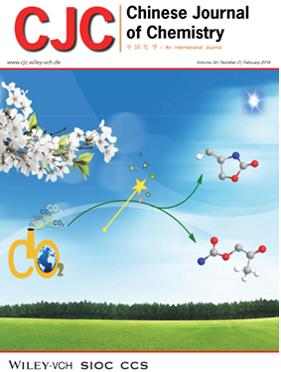
8. Chang Qiao, Yu Cao, Liang-Nian He*, Transition Metal-Catalyzed Carboxylation of Terminal Alkynes with CO2, Mini-Rev. Org. Chem., 2018, 15, 283-290. [link]
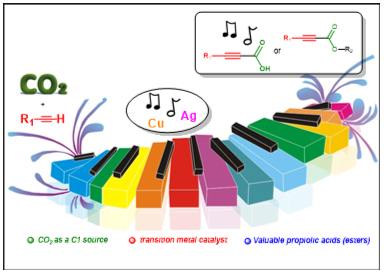
Abstract: The coupling reaction of terminal alkynes and CO2 provides a promising way to synthesize propiolic acids. Among the existing catalytic systems, transition-metal copper and silver exhibit excellent catalytic efficiency under mild conditions probably being attributed to the activation of C-C triple bond of terminal alkynes. In this aspect, efficient strategies for activating both substrate and CO2 are often smart choices. This review summarizes the development trend of the Cu/Ag-catalyzed carboxylation reactions of terminal alkynes with CO2, and representative examples are also discussed in detail.
9. Jia-Ning Xie, Liang-Nian He*, Hong-Chen Fua, Ning Wang and Mei-Yan Wang, Sodium Acetate-Promoted Oxa-Michael-Aldol [3+2] Annulation Reactions: Facile Access to the Fused Heterocycle, Current Catal., 2018, 7, 60-64. [link]

Abstract: A highly active base-promoted system based on NaOAc•3H2O has been designed for the oxa-Michael-aldol [3+2] annulation reactions of internal alkynotes with N-hydroxyphthalimides, giving a series of pharmaceutically attractive 3a-hydroxyisoxazolo[3,2-a]isoindol-8(3aH)-ones in synthetically useful yields of up to 98%. Only 10 mol% NaOAc•3H2O is needed for the reaction at room temperature within 6 h. Besides, a plausible base-promoted intermolecular [3+2] oxa-Michael-aldol type mechanism is proposed.
10. Zhi-Hua Zhou, Shu-Mei Xia, and Liang-Nian He*, Green Catalysis for Efficient Three-Component Reaction of Carbon Dioxide, Propargylic Alcohols and Nucleophiles, Acta Phys. -Chim. Sin., 2018, 34, 838-844. [link]

Abstract: Transformation of carbon dioxide into valuable organic molecules has attracted considerable attention over the past decades. In this regard, three-component reaction of CO2, propargylic alcohols and nucleophiles including amines, water and alcohols to prepare useful carbonyl compounds, for instance, carbamates, oxazolidinones, α-hydroxyl ketones and organic carbonates, is particularly appealing due to advantages of step and atom economy. CO2 is of thermodynamic stability and kinetic inertness, leading to the reactions involving CO2 are commonly thermodynamically unfavorable. We have developed an efficient three-component reaction of CO2, propargylic alcohols and nucleophiles to offer thermodynamically favorable ways for converting CO2 into cyclic carbonates and 2-oxazolidinones with vicinal diols or 2-aminoethanols. This review aims to summarize and discuss recent advances on three-component reaction of CO2, propargylic alcohols with nucleophiles to prepare various carbonyl compounds promoted by both metal catalysts and organocatalysts.
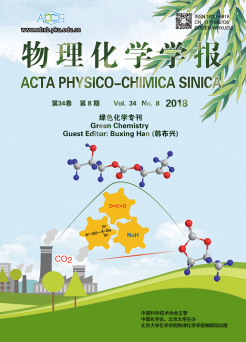
11. 刘晓放,何良年,二氧化碳的高值化利用,科学, 2018, 70, 14-19.
12. Xue-Dong Li, Yu Cao, Ran Ma, Liang-Nian He*, Thermodynamically favorable protocol for the synthesis of 2-oxazolidinones via Cu(I)-catalyzed three-component reaction of propargylic alcohols, CO2 and 2-aminoethanols, J. CO2 Util., 2018, 25, 338-345. [link]

Abstract: Efficient CuI/1,10-phen-catalyzed three-component cascade reaction of propargylic alcohols, CO2, and 2-aminoethanols has been firstly developed for the thermodynamically favourable preparation of 2-oxazolidinones. In the presence of commercially available CuI, 1,10-phen (1,10-phenanthroline) and t-BuOK, the cascade reaction afforded the desired products in good to excellent yields with a broad substrate scope (14 examples). The predicted copper complex Cu2I2(phen)2 in situ formed from CuI and 1,10-phen could activate the triple bond through coordination. The isolation of α-alkylidene cyclic carbonate as the reaction intermediate suggests that the carboxylative cyclization of propargylic alcohol with CO2, followed by ring-opening reaction, is involved in the one-pot three-component cascade reaction.
13. Yu Cao, Ran Ma, Ning Wang, Mei-Yan Wang, Xue-Dong Li, Liang-Nian He*, Selective hydrodeoxygenation of β-O-4 model compounds and aromatic ketones promoted by palladium chloride with acidic CO2/MeOH system, J. CO2 Util., 2018, 24, 328-333. [link]

Abstract: Selective hydrogenolysis is a crucial challenge for lignin valorization. A PdCl2-catalyzed hydrogenolysis of C-OH bond of various lignin β-O-4 alcohol model compounds was developed for preparation of corresponding phenethoxybenzene in 78-98% isolated yield. Notably, the introduction of low-pressure CO2 (1 MPa) remarkably improves the reaction efficiency and selectivity of phenethoxybenzene. Neither over-reduction of aromatic ring nor further debenzylation was detected. This is understandable that the in situ methylcarbonic acid generated from CO2 and methanol acts as an acidic catalyst and enhances the leaving ability of hydroxyl group of β-O-4 alcohols. Besides, the present PdCl2/CO2/MeOH catalyst system proved to be effective for reductive cleavage of C-O bonds of β-O-4 ketones, producing ethylbenzenes accompanied with phenols in high yields. Furthermore, this protocol could also be extended to selective hydrodeoxygenation of the carbonyl group to methylene in aromatic ketones. As a sound reaction medium, such in situ CO2/MeOH acidic system could be inherently neutralized by depressurizing CO2, providing feature advantages for simple post-processing and none waste disposal.
14. Yu Cao, Xing He, Ning Wang, Hong-Ru Li, and Liang-Nian He*, Photochemical and Electrochemical Carbon Dioxide Utilization with Organic Compounds, Chin. J. Chem., 2018, 36, 644-659. [link]
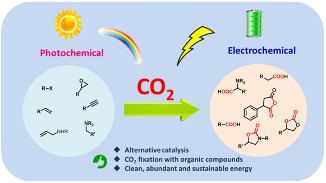
Abstract: In the last few years, photochemical and electrochemical CO2 transformations have attracted increasing attention in response to topical interest in renewable energy and green chemistry. The present minireview offers an overview about the current approaches for the photochemical and electrochemical carbon dioxide fixation with organic compounds. Valuable products, including carboxylic acids and heterocyclic compounds, are accessible through carboxylation and carboxylative cyclization, respectively. In photochemical and electrochemical processes, photo- or electro-induced radical ions or other high-energy organic compounds are considered as key intermediates to react with CO2. Besides, activation of CO2 to produce radical anions has also been reported.
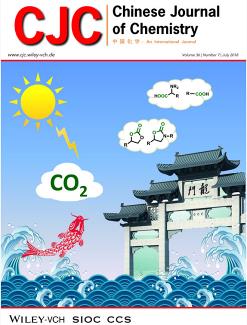
15. Mei-Yan Wang, Xiao-Ya Li and Liang-Nian He*, Green Chemistry Education and Activity in China, Current Opinion in Green & Sustainable Chem., 2018, 13, 123-129. [link]
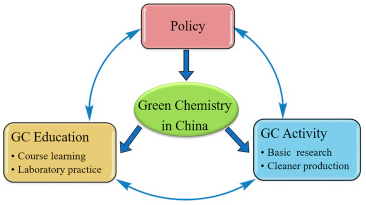
Abstract: With the increase of global environmental pollution, green chemistry has been an inevitable trend in the development of chemistry and chemical engineering, thus attracting much attention from the academia to industry and to governments. As a response to the “green challenge”, the so-called green chemistry movement has spread all over the world. In this perspective, we would like to present main programs associated with green chemistry in China, with a focus on green chemistry education and related activities.
16. Chang Qiao, Xiang-Yang Yao, Xiao-Fang Liu, Hong-Ru Li*, Liang-Nian He*, Efficient Iron-Catalyzed Reductive N-Alkylation of Aromatic Amines with Carboxylic Acid and Hydrosilane, Asian J. Org. Chem., 2018, 7, 1815-1818. [link]
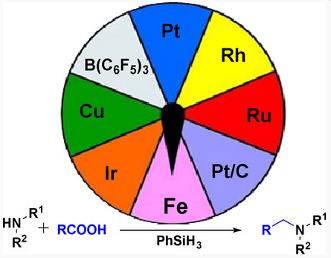
Abstract: Development of efficient catalysis for the alkylation of amines with carboxylic acid is attracting much attention. Herein, we would like to report an earth‐abundant iron‐catalyzed protocol for N‐alkylation of amines using carboxylic acid as alkyl source and phenylsilane as reducing agent. With Fe2(CO)9 as a catalyst, a broad range of primary and secondary amines are successfully converted to the corresponding tertiary amines. Furthermore, this N‐alkylation mainly goes through the amide pathway; while the aldehyde pathway can not be ruled out.
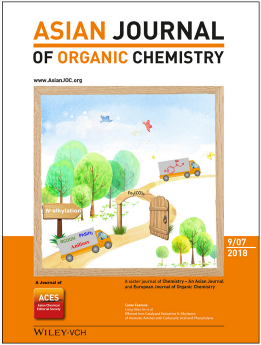
17. Chang Qiao, Xiao-Fang Liu, Hong-Chen Fu, Hao-Peng Yang, Zhi-Bo Zhang, Liang-Nian He*, Directly Bridging Indoles to 3,3’-Bisindolylmethanes Using Carboxylic Acids and Hydrosilanes under Mild Conditions, Chem. Asian J., 2018, 2664-2670. [link]
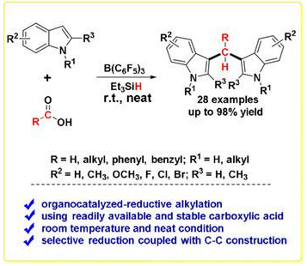
Abstract: A straightforward Lewis acid‐promoted protocol for 3,3′‐bisindolylmethanes (BIMs) synthesis by reductive alkylation of indoles at the C3 position with carboxylic acids in the presence of hydrosilane was developed for the first time. Instead of aldehydes, more readily available, stable, and easy‐to‐handle carboxylic acids have been employed as alternative alkylating agents. As an efficient organocatalyst, B(C6F5)3 enables the reductive alkylation of various substituted indole derivatives with carboxylic acids with up to 98 % yield at room temperature and under neat conditions. This metal‐free strategy offers an alternative approach for the direct functionalization of indoles to BIMs with carboxylic acids and such protocol allows selective reduction of carboxylic acid to aldehyde in combination with C−C bond formation.
18. Xing He, Yu Cao, Xian‐Dong Lang, Ning Wang, Liang‐Nian He*, Integrative Photoreduction of CO2 with Subsequent Carbonylation: Photocatalysis for Reductive Functionalization of CO2, ChemSusChem, 2018, 11, 3382-3387.[link]

Abstract: Efficient conversion of CO2 into fuels and chemicals with solar energy would be promising, but also faces great challenge. In this context, we describe the photoreductive functionalization of CO2 to construct new C−C, C−N, and C−O bonds through the respective Pd‐catalyzed Suzuki carbonylation, aminocarbonylation, and alkoxycarbonylation of aryl iodides with CO in situ generated through the photoreduction of CO2. This protocol opens up an alternative avenue for CO2 utilization by harnessing solar energy.
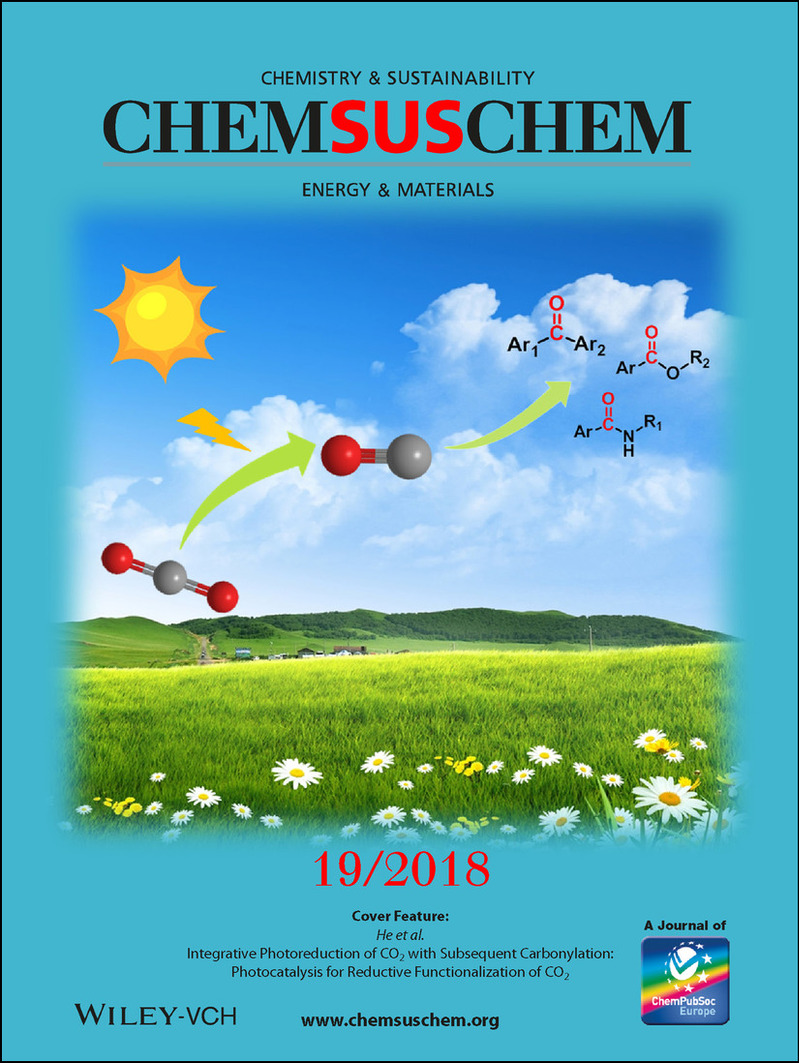
19. Xue-Dong Li#, Shu-Mei Xia#, Kai-Hong Chen, Xiao-Fang Liu, Hong-Ru Li* and Liang-Nian He*, Copper catalysis: ligand-controlled selective N-methylation or N-formylation of amines with CO2 and phenylsilane. Green Chem., 2018, 20(21), 4853-4858. [link]

Abstract: Cupric subcarbonate (Cu2(OH)2CO3) was found to be effective for the reductive functionalization of CO2 to produce formamides and methylamines with phenylsilane as reductant. Interestingly, N-formylation and N-methylation were switched on/off by subtly choosing the ligand: DPPB (1,4-bis(diphenylphosphino)butane) promoted N-methylation whereas Ph2CyP (diphenylcyclohexylphosphine) favored for N-formylation.
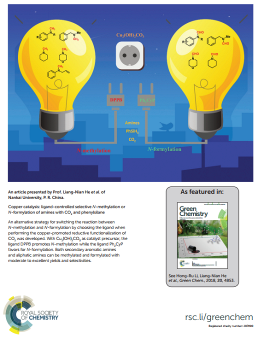
20. Yu Cao, Ning Wang, Xing He, Hong-Ru Li* and Liang-Nian He*, Photocatalytic Oxidation and Subsequent Hydrogenolysis of Lignin β-O-4 Models to Aromatics Promoted by In Situ Carbonic Acid, ACS Sustain. Chem. Eng., 2018, 6(11), 15032-15039. [link]
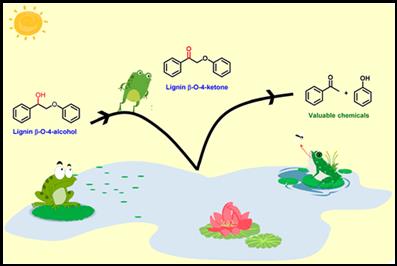
Abstract: The cleavage of C–O bond in lignin β-O-4 model compounds to form aromatics has been achieved via a two-step process, comprising visible-light photocatalytic oxidation and in situ carbonic acid-facilitated hydrogenolysis. In the first step, with readily available persulfate as radical initiator and cheap copper as catalyst, the secondary alcohol in the β-O-4 alkyl-aryl ether linkage is selectively oxidized to the corresponding ketone in up to 99% yield under visible-light irradiation. The second step features the C–O bond cleavage of lignin β-O-4 ketones promoted by in situ acidic EtOH/H2O/CO2 system in the presence of zinc powder, producing acetophenones and phenols in high yield. This protocol provides a novel alternative to selective fragmentation of β-O-4 linkage to aromatic monomers under mild reaction conditions.
21. Shumei Xia, Yu Song, Xuedong Li, Hongru Li* and Liang-Nian He*, Ionic Liquid-Promoted Three-Component Domino Reaction of Propargyl Alcohols, Carbon Dioxide and 2-Aminoethanols: A Thermodynamically Favorable Synthesis of 2-Oxazolidinones. Molecules, 2018, 23(11), 3033. [link]

Abstract: To circumvent the thermodynamic limitation of the synthesis of oxazolidinones starting from 2-aminoethanols and CO2 and realize incorporation CO2 under atmospheric pressure, a protic ionic liquid-facilitated three-component reaction of propargyl alcohols, CO2 and 2-aminoethanols was developed to produce 2-oxazolidinones along with equal amount of α-hydroxyl ketones. The ionic liquid structure, reaction temperature and reaction time were in detail investigated. And 15 mol% 1,5,7-triazabicylo[4.4.0]dec-5-ene ([TBDH][TFE]) trifluoroethanol was found to be able to synergistically activate the substrate and CO2, thus catalyzing this cascade reaction under atmospheric CO2 pressure. By employing this task-specific ionic liquid as sustainable catalyst, 2-aminoethanols with different substituents were successfully transformed to 2-oxazolidinones with moderate to excellent yield after 12 h at 80 °C.
22. Shu-Mei Xia, Kai-Hong Chen, Hong-Chen Fu and Liang-Nian He*, Ionic Liquids Catalysis for Carbon Dioxide Conversion With Nucleophiles. Front. Chem., 2018, 6: 462. DOI: 10.3389/fchem.2018.00462. [link]
Abstract: Carbon dioxide, as a promising C1 synthon, has attracted great interest in organic synthesis. Due to the thermodynamic stability and kinetic inertness of CO2, developing efficient strategies for CO2 activation and subsequent conversion is very crucial. In this context, Ionic liquids (ILs) show great potential for capturing and activating CO2 owing to their unique structures and properties, making them become ideal alternatives to volatile organic solvents and/or catalysts for CO2 transformation. This minireview aims at summarizing ILs-promoted reactions of CO2 with N-nucleophiles (primary amines)/O-nucleophiles (primary alcohols, water). Two catalytic systems i.e., metal/ILs binary systems such as Cu/ILs systems and Ag/ILs systems as well as single ILs systems including anion-functionalized ILs and bifunctionalized ILs have been developed for CO2 catalytic conversion, for instance, carboxylative cyclization of nucleophiles e.g., propargylic alcohols, amines, 2-aminobenzonitriles and o-aminobenzenethiol, and formylation of amines or 2-aminothiophenols with hydrosilanes to afford various value-added chemicals e.g., cyclic carbamates, unsymmetrical organic carbonates, α-hydroxyl ketones, and benzimidazolones. In a word, IL could provide a powerful tool for efficient CO2 utilization.